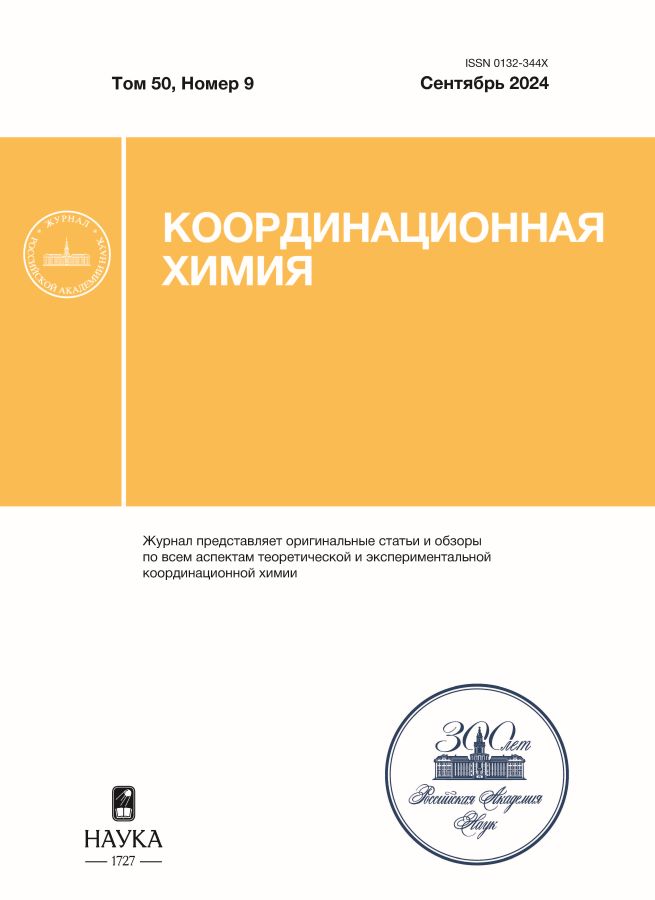Cadmium(II)-Organic Frameworks with the Polynuclear Unit: Dimensionality Control and Luminescence Response to Pyridine
- Authors: Dubskikh V.A.1, Lysova A.A.1, Samsonenko D.G.1, Dybtsev D.N.1
-
Affiliations:
- Nikolaev Institute of Inorganic Chemistry, Siberian Branch, Russian Academy of Sciences
- Issue: Vol 50, No 9 (2024)
- Pages: 566-576
- Section: Articles
- URL: https://rjonco.com/0132-344X/article/view/667663
- DOI: https://doi.org/10.31857/S0132344X24090047
- EDN: https://elibrary.ru/LXOZCY
- ID: 667663
Cite item
Abstract
New porous metal-organic frameworks (MOF) [Cd7(Btdc)7(Bpa)2(Dmf)2(H2O)2] · 15Dmf · 2H2O (I) and [Cd7(Btdc)7(Bpe)2(Dmf)2] · 15Dmf · 3H2O (II) (H2Btdc is 2,2’-bithiophene-5,5’-dicarboxylic acid, Bpa is 1,2-bis(4-pyridyl)ethane, Bpe is 1,2-bis(4-pyridyl)ethylene, and Dmf is N,N-dimethylformamide) are synthesized under solvatothermal conditions. The structures and compositions of the compounds are determined by single-crystal X-ray diffraction (XRD) (CIF files ССDС nos. 2364290 (I) and 2364289 (II)) and confirmed by powder XRD, elemental analysis, thermogravimetry, and IR spectroscopy. Compound I has a 2D structure based on the heptanuclear discrete building unit {Cd7} with the linear structure. Compound II is a 3D MOF in which the {Cd7} building units are linked into a continuous chain motif due to additional interactions. The formation of discrete or continuous chains is directly related to the nature of the N-donor bridging ligand (Bpe or Bpa). Compounds I and II have open structures with the accessible volume about 50%. The solvate molecules are replaced by thiophene, benzene, and pyridine, and the luminescence properties of the prepared adducts are studied. Luminescence quenching in the presence of thiophene and an increase in the luminescence intensity in the presence of pyridine accompanied by a change in the quantum yield by 4–5 times are shown.
Keywords
Full Text
About the authors
V. A. Dubskikh
Nikolaev Institute of Inorganic Chemistry, Siberian Branch, Russian Academy of Sciences
Email: dan@niic.nsc.ru
Russian Federation, Novosibirsk
A. A. Lysova
Nikolaev Institute of Inorganic Chemistry, Siberian Branch, Russian Academy of Sciences
Email: dan@niic.nsc.ru
Russian Federation, Novosibirsk
D. G. Samsonenko
Nikolaev Institute of Inorganic Chemistry, Siberian Branch, Russian Academy of Sciences
Email: dan@niic.nsc.ru
Russian Federation, Novosibirsk
D. N. Dybtsev
Nikolaev Institute of Inorganic Chemistry, Siberian Branch, Russian Academy of Sciences
Author for correspondence.
Email: dan@niic.nsc.ru
Russian Federation, Novosibirsk
References
- Agafonov M.A., Alexandrov E.V., Artyukhova N.A. et al. // J. Struct. Chem. 2022. V. 63. P. 671.
- Amooghin A.E., Sanaeepur H. et al. // Chem. Soc. Rev. 2022. V. 51. P. 7427.
- Chen K., Mousavi S.H. et al. // Chem. Soc. Rev. 2022. V. 51. P. 1139.
- Shen Y., Tissot F., Serre C. // Chem. Sci. 2022. V. 13. P. 13978.
- Fang X., Zong, B., Mao, S. // Nano-Micro Lett. 2018. V. 10. P. 63.
- Sohrabi H., Ghasemzadeh S., Ghoreishi Z. et al. // Mater. Chem. Phys. 2023. V. 299. Р. 127512.
- Tranchemontagne D.J., Mendoza-Cortes J.L., O′Keeffe M. et al. // Chem. Soc. Rev. 2009. V. 38. P. 1257.
- Sapianik A.A., Fedin V.P. // Russ. J. Coord. Chem. 2020. V. 46. P. 443.
- Borsari M. // Encyclopedia of Inorganic and Bioinorganic Chemistry. John Wiley & Sons, Ltd., 2014. P. 1.
- Borsari M. // Encyclopedia of Inorganic Chemistry. John Wiley & Sons, Ltd., 2006. P. 1.
- Trofimova O.Y., Meshcheryakova I.N. et al. // CrystEngComm. 2024. V. 26. P. 3077.
- Guo X.-Z., Chen S.-S. et al. // ACS Omega. 2019 V. 4. P. 11540.
- Guo Z., Cao R., Li. X. // Eur. J. Inorg. Chem. 2007. V. 5. P. 742.
- Dubskikh V.A., Lysova A.A., Samsonenko D.G. et al. // J. Struct. Chem. 2022. V. 63. P. 1831.
- Dubskikh V.A., Lysova A.A., Samsonenko D.G. et al. // J. Struct. Chem. 2020. V. 61. P. 1800.
- Svetogorov R.D., Dorovatovskii P.V., Lazarenko V.A. // Crystal Research and Technology. 2020. V. 55. Р. 1900184.
- Lazarenko V.A., Dorovatovskii P.V., Zubavichus Y. et al. // Crystals. 2017. V. 7. P. 325.
- Kabsch W. // XDS Acta Crystallogr. D. 2010. V. 66. P. 125.
- Sheldrick G.M. // Acta Crystallogr. A. 2015. V. 71. P. 3.
- Sheldrick G.M. // Acta Crystallogr. C. 2015. V. 71. P. 3.
- Hübschle C.B., Sheldrick G.M., Dittrich B. // J. Appl. Cryst. 2011. V. 44. P. 1281.
- Speck A.L. // Acta Crystallogr. C. 2015. V. 71. P. 9.
- Yudina Y.A., Samsonova A.M., Bolotov V.A. et al. // J. Struct. Chem. 2021. V. 62. P. 1599.
- Einkauf J.D., Ortega R.E. et al. // New J. Chem. 2017. V.41. P. 10929.
- Zhao J., Wang X.-L., Shi X. et al. // Inorg. Chem. 2011. V. 50. P. 3198.
Supplementary files















